#Best San Francisco Architects
Text
Best San Francisco Architects

Unveiling the Best San Francisco Architects: Shaping a City's Skyline
San Francisco, a city renowned for its breathtaking landscapes, diverse culture, and iconic landmarks, has long been a canvas for architectural innovation. From the majestic Golden Gate Bridge to the Victorian-era Painted Ladies, the city's architecture reflects a rich tapestry of history, innovation, and artistry. Behind every iconic building and innovative design are the brilliant minds of architects who have left an indelible mark on the city. In this article, we'll delve into the world of architecture in San Francisco and explore some of the best architects who have contributed to shaping the city's skyline and character.
Julia Morgan: Pioneering Architect of the Hearst Castle Julia Morgan was a trailblazing architect whose impact extended well beyond the boundaries of San Francisco. Born in San Francisco in 1872, she shattered gender norms in the field of architecture and became the first woman to graduate from the esteemed École des Beaux-Arts in Paris. Morgan is most celebrated for her work on the Hearst Castle, a majestic estate nestled on the Californian coast. Her expertise in blending various architectural styles, from Mediterranean Revival to Gothic Revival, is evident in the grandeur of the castle. Beyond the Hearst Castle, Morgan designed numerous iconic buildings in San Francisco, such as the Fairmont Hotel, showcasing her versatility and impeccable design sensibilities.
Frank Lloyd Wright's Influence on San Francisco Frank Lloyd Wright, a name synonymous with architectural genius, contributed significantly to the architectural landscape of San Francisco. Although not a San Francisco native, his influence is undeniable. Wright's principles of organic architecture, emphasizing harmony between human habitation and the natural world, are reflected in many San Francisco homes. Notably, the V.C. Morris Gift Shop on Maiden Lane stands as an architectural gem, illustrating Wright's concept of "organic architecture." The design's fluid lines and integration with the environment make it a must-see for architecture enthusiasts.
The Innovative Legacy of Bernard Maybeck Bernard Maybeck, another influential figure in San Francisco architecture, was known for his innovative approach and love for the Arts and Crafts movement. His masterpiece, the First Church of Christ, Scientist in Berkeley, showcases his mastery in crafting spaces that harmonize with nature and incorporate distinctive, handcrafted details. Maybeck's work has left an indelible mark on San Francisco's architecture, inspiring future generations of architects to embrace both functionality and artistry in their designs.
Sustainable Design Champion: William McDonough In the 21st century, San Francisco has seen a surge in sustainable architecture, and William McDonough is at the forefront of this movement. His Cradle to Cradle philosophy emphasizes the importance of designing buildings and products with a focus on sustainability and environmental responsibility. McDonough's work, such as the San Francisco Federal Building, serves as a beacon for green architecture. The building is not just a government office but a living testament to how sustainable design can be integrated into urban landscapes.
An Icon of Modernism: Richard Neutra Richard Neutra was a visionary architect who introduced the principles of modernism to San Francisco. His designs, characterized by clean lines, open spaces, and an integration of indoor and outdoor elements, have been influential in shaping the city's modern architectural identity. The VDL Research House, though not in San Francisco, is a prime example of Neutra's iconic designs. His work in the Bay Area, like the Largent House, epitomizes the modernist movement's simplicity and elegance.
The Contemporary Vision of Stanley Saitowitz Stanley Saitowitz, a contemporary architect based in San Francisco, is known for his avant-garde designs that challenge conventional aesthetics. His work often involves the use of industrial materials, sharp angles, and minimalist concepts. The Yerba Buena Lofts in San Francisco, a sleek and innovative residential project, reflects his cutting-edge design approach. Saitowitz's ability to fuse functionality with artistic expression has made him a prominent figure in the city's architectural scene.
Renzo Piano and the California Academy of Sciences Renzo Piano, an internationally acclaimed architect, made a significant impact in San Francisco with the design of the California Academy of Sciences. The building, with its undulating green roof, is a prime example of sustainable design that harmonizes with its surroundings. Piano's innovative use of materials and his commitment to ecological responsibility have set a high standard for future architectural projects in the city.
San Francisco's architecture is a dynamic blend of historic landmarks, iconic structures, and cutting-edge designs. The architects who have worked in the city over the years have left an indelible mark, contributing to its ever-evolving skyline and cultural identity. From the timeless elegance of Julia Morgan to the sustainable innovations of William McDonough, the architectural diversity in San Francisco is a testament to the city's commitment to pushing the boundaries of design and embracing the rich history of architectural evolution.
As we reflect on the contributions of these architects, we're reminded that San Francisco's architectural journey is far from over. Emerging talents and visionaries continue to shape the city's skyline, each adding their unique chapter to the story of this vibrant and ever-changing metropolis. In the years to come, we can look forward to more iconic designs that will further solidify San Francisco's reputation as a hub of architectural excellence and innovation.
1 note
·
View note
Text

Late jazz legend Dave Brubeck's 1953 MCM cantilevered house in Oakland, California is on the market for $3M. It has 4bds, 4ba, and is cantilevered 16 ft. in the air. Designed by architect Beverley D. Thorne.
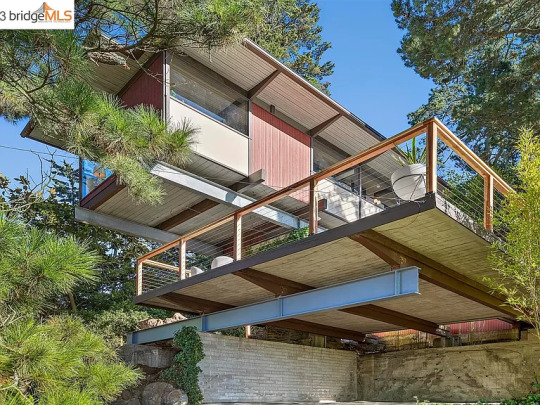

Five steel beams project in two directions allowing the house to "float" above the challenging hillside lot, while preserving the natural beauty of a site that commands a magnificent panoramic view of the San Francisco Bay.
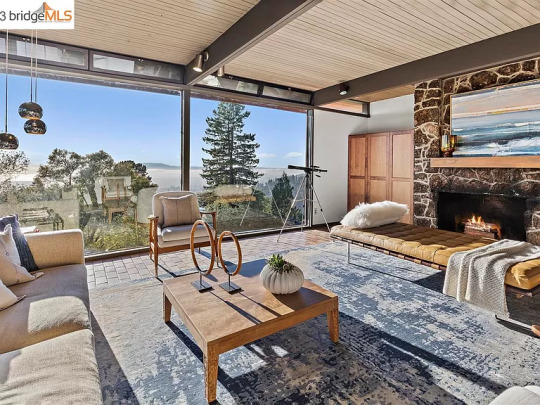

The spacious living room features glass walls for a great view, plus a stone fireplace.

This deck has the best view of San Francisco Bay.


It's a dinette now, but it used to be the music room where the Dave Brubeck Quartet practiced. It's famous for the rock projecting out of the center of the house.

I think the rock is the coolest feature. It sort of looks like a frog.


The large kitchen has been updated, but the cabinetry looks like original MCM style.


A small area of the kitchen has a bistro table set and opens to this deck.


Large primary bedroom is divided into 2 areas.

Bedroom #2 has a nook with a desk.

Bedroom #3 is smaller and painted a pleasant blue.

Small exercise space has a nice view.

This patio looks like it's almost as high as the roof.

The drive leading up to the front door has a carport.

You can see here how the house is built among the rocks.
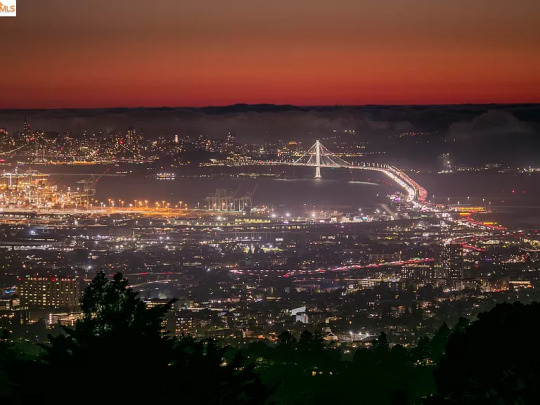
Check out the view at night.
Attractive home balanced above a rocky .29 acre lot.

Aerial view showing the location.
#unique mid century modern home#mid century modern home#cantilevered house#dave brubeck house#old house dreams#houses#house tours#home tour
263 notes
·
View notes
Text
1900s futurism

I'm on tour with my new, nationally bestselling novel The Bezzle! Catch me in TUCSON (Mar 9-10), then SAN FRANCISCO (Mar 13), Anaheim, and more!

I'm profoundly skeptical of the idea that the future can be predicted, and doubly skeptical that sf writers are any kind of prophet. The former grotesque fatalism (if the future can be predicted, then what we do doesn't matter); the latter is tragicomic hubris.
If you'd like an essay-formatted version of this thread to read or share, here's a link to it on pluralistic.net, my surveillance-free, ad-free, tracker-free blog:
https://pluralistic.net/2024/03/07/the-gernsback-continuum/#wheres-my-jetpack
That said, few people have been more consistently useful in understanding and anticipating (and yes, building) the future than my friend and colleague Karl Schroeder, whom I've known since I was 16 years old. Karl was the first person I heard say the world "internet." Also: "fractal," "World Wide Web," "ftp," and numerous other touchstones of the future just over the horizon.
Karl is, in fact, a futurist ("foresight consultant") who approaches the work with the same shrewd insight, wild imagination and humility that he brings to his fiction. In a new essay written with both his futurist and sf writer hats on, he nails down the toxic shadow cast by the 20th century sf, or, as he calls it, "The Science Fiction of the 1900s":
https://kschroeder.substack.com/p/the-science-fiction-of-the-1900s
Karl starts by describing the odd "double vision" of the future of the 1900s. On the one hand, many of us (myself included) were convinced that nuclear armageddon was inevitable. Unlike the unhinged architects of the nuclear arms-race, realists understood that a nuclear war would effectively end the future. As Einstein put it, "I know not with what weapons World War III will be fought, but World War IV will be fought with sticks and stones."
But the flipside of that certainty that the future would end with the first nuclear strike was the belief that if we could just somehow walk the tightrope over the chasm of nuclear holocaust, we'd emerge in a future worth looking forward to: "a new era of peace and prosperity for all."
Contrast that with the existential dread of today's polycrisis: environmental collapse and political decay up to and including fascism. These aren't the binary proposition of nuclear annihilation vs Utopia – rather, they're a continuum of worse-and-better outcomes of every description. As Karl writes: "It’s not that simple. Our future now is an exhausting spectrum of scenarios, each with its own promise, and its own problems."
For Karl, we have entered a new epoch, but we've dragged in the long-expired way of imagining (and hence creating and navigating) the future with us. What makes this a new epoch? For Karl, it's the kind of future on our horizon. He cites Charles C Mann’s 1491, a superb history of the Americas before Columbus:
https://www.penguinrandomhouse.com/books/107178/1491-second-edition-by-charles-c-mann/9781400032051/readers-guide/
1491 radically reframes "the patchwork of propaganda and inference" that makes up the received narrative of the so-called "New World." It describes a land of flourishing cities, art, science and culture "in the Americas while Rome was just getting its act together." Contact with colonizing Europeans was a disaster for First Nations people, who call this period "The Invasion." It was an epochal break.
Futurism is an inextricably historical discipline. The willingness of some settler-colonialists states to consider this epochal break forces us to reframe our literal place in history, the story of the land under our feet. At its best, this futuro-historical work can begin the long work of reconciliation, as with the Canadian government's promise of $23b in reparations for the First Nations people who were kidnapped as children and sent to murderous "residential schools" before, during and after the Sixties Scoop.
The sf of the 1900s is no longer fit for purpose, if it ever was. It's a literature that was steered by open fascists like John W Campbell, who explicitly saw the literature as a means of inculcating a societal narrative of the triumph of white, corporate technocracy over all other forms of government:
https://locusmag.com/2019/11/cory-doctorow-jeannette-ng-was-right-john-w-campbell-was-a-fascist/
Karl isn't the first sf writer to try to overturn this orthodoxy – indeed, it was continuously challenged by radicals within the field, as with the New Wave, personified by the likes of Samuel Delany and Judith Merril (who both mentored and introduced Karl and me):
https://pluralistic.net/2020/08/13/better-to-have-loved/#neofuturians
The cyberpunks took a good hard run at it, too. For plenty of writers (including me), Bruce Sterling and William Gibson's 1981 story "The Gernsback Continuum" was a wake-up call:
http://writing2.richmond.edu/jessid/eng216/gernsback.pdf
Not for nothing, William Gibson has long insisted that his 1984 classic Neuromancer should be read as utopian: after all, it depicts a future in which the inevitable nuclear war only reduces a few cities to radioactive ash, sparing the rest of the planet.
Bruce Sterling once paid me the supreme compliment of describing a 2003 story I wrote about the ways that algorithms will enshittify self-driving cars as "making everybody else in the business look like they live in a dark basement growing on the mulch from old STAR TREK scripts":
https://craphound.com/stories/2005/10/12/human-readable/
Schroeder – along with today's new radical sf writer cohort – wants to fashion a fictional futurism that is fit for this world and its crisis: "in our modern technological society, science fiction tells us what to spend our time and money on." The fact that our mediocre billionaires are mired in the sf of the 1900s means that we're getting some decidedly old-fashioned futures.
For Karl, Musk is a poster-child for this profoundly conservative, backwards-looking vision: "He’s fighting the intellectual battles of the last century, a 1900s hero dropped into the 2000s with an unlimited budget to reshape the future to fit the era he’s from." Musk's obsessions – "Space flight. Settling Mars. Cyberpunk-style brain-computer interfaces. Artificial Intelligence. Self-driving electric cars. Humanoid robots." – are 1900s science fiction.
Ironically, much of this fiction labels itself "hard sf," despite the fact that interstellar travel is utter fantasy – as is mass-scale, near-term interplanetary civilization:
https://pluralistic.net/2024/01/09/astrobezzle/#send-robots-instead
Karl wants "a future for the 2000s." He points to some efforts to make this happen, like Neal Stephenson's Hieroglyph anthology, edited by Ed Finn and Kathryn Cramer:
https://www.harpercollins.com/products/hieroglyph-ed-finnkathryn-cramer
The "Hieroglyph" is Stephenson's shorthand for a recognizable, tangible, meme-able gizmo or other touchstone for a 2000s-era vision of the future – a replacement for jetpacks and flying cars. Karl's story for the anthology, "Degrees of Freedom," focuses on an abstraction (governance: "the single most important thing humanity can focus its creative energies on right now"), and by Karl's own admission, it's not quite the hieroglyph Stephenson was looking for.
But Karl did come up with a hieroglyph in a later work, the "deodands" of 2019's Stealing Worlds – a software agent "that believes it is some natural system, such as a river or forest, and acts in its own self-interest, that being the preservation and thriving of that natural system":
https://memex.craphound.com/2019/06/18/karl-schroeders-stealing-worlds-visionary-science-fiction-of-a-way-through-the-climate-and-inequality-crises/
(My own contribution to Hieroglyph was very gadget heavy – "The Man Who Sold the Moon," about autonomous lunar 3D printers. It won the Sturgeon Award):
https://memex.craphound.com/2015/05/22/the-man-who-sold-the-moon/
I've been impressed with Karl since the day I met him in 1987. There's no one whose thoughts on the future I'm more interested in hearing. I don't think that's a coincidence, either: Karl is an autodidact who was raised by a Mennonite TV repairman – the first TV repair shop in the Canadian prairies. If you want to understand the future, try being raised by someone who takes that kind of deliberate approach to which technology to adopt, and how.

Name your price for 18 of my DRM-free ebooks and support the Electronic Frontier Foundation with the Humble Cory Doctorow Bundle.

If you'd like an essay-formatted version of this post to read or share, here's a link to it on pluralistic.net, my surveillance-free, ad-free, tracker-free blog:
https://pluralistic.net/2024/03/07/the-gernsback-continuum/#wheres-my-jetpack
#pluralistic#science fiction#futurism#the future#reactionaries#tescreal#retrofuturism#scientifiction#karl schroeder#1491#genocide
122 notes
·
View notes
Text
Sugar Daddy Erik Face Claims:

Sienna. 26
Sienna is from Texas. She moved to San Francisco to go to nursing school. She has a bond with her Mother’s sister and her cousins. Her mom and dad passed away.

Selena. 24 (this is just an over Al picture to describe her she’s Latina) friend to Sienna. They met in college and bonded because of Nursing. Eventually they messed around. Faith has feelings for Sienna.

Carrie. 45
Carrie is best friends to Faith and she’s an Attorney.
Faith. 44
Faith is Erik’s second wife. Faith is a Therapist. Faith couldn’t have children.
Vivica. 56
Vivica is Erik’s first wife. They met each other at a party in LA when Erik was in his twenties. She was a prestigious woman born into a family with money.

Leo. 46
Leo. Born and raised in Seattle, Washington. A famous painter who eventually went to medical school in San Francisco to become an Anesthesiologist. Before that, he traveled a lot, backpacking through Australia, Ireland, Peru, and plenty of other places. Erik and himself became close when they both attended a medical fellowship together. After long nights in the ER, they would meet up for drinks at a local bar. Leo is divorced just like Erik, an estranged wife that he provides for along with his three children. All in all, Erik brought them together and they are inseparable.

Jamie. 49
Jamie is the eldest of the friend group at the age of forty-nine. He’s a famous producer from NY that decided to move to California after a falling out with his business partner. He also wanted to branch out and do his own thing so he decided to take his talents to California. He settled in Oakland and from there he made a name for himself. Erik and Jamie met back in the 90s when Erik was going to college in NY. Erik would frequent a local club that held cyphers and there is where he met Jamie. They have been friends ever since.

Toni. 40
Toni is a childhood friend of Erik’s. He’s an Intellectual Property Lawyer who was born in California to his Filipino mother and African American father. Out of all of them, Toni suffered the most hardships. Poor upbringing, alcoholic and abusive father, multiple siblings, life turned to crime to provide for his family, and out of all of that, he has two college degrees and makes 162,000 a year.
Kevin 😒
Just know he’s an Architect and he’s married to Carrie. Not much will be said about him lol
#sugardaddyerik#nahimjustfeelingit-writes#killmonger imagine#killmonger fanfiction#killmonger smut#erik killmonger
27 notes
·
View notes
Text
Silicon Valley fic Masterlist
Hallfoyle, mine:
Schrödinger's cat
"First you say ‘I like you’ as if I haven’t spent the last three years watching you being a mean sarcastic asshole and not caring about anyone’s feelings. Then you add ‘not like that’, disappear, and proceed to never mention it again. And go to extreme lengths to avoid me. So, for fuck’s sake, Gilfoyle, what is your deal?”
-/-
Monica is furious. Gilfoyle falls back on science and philosophy as a way to address his feelings. Naturally.
The Road Not Taken
Laurie offers Monica everything she ever wanted if she goes back to Bream-Hall. But is it too late now that she's helming Pied Piper? Did she make the right choice, risking it all for a dream and a New Internet?
What Are You Waiting For
Gilfoyle has the chance to write the algorythm that will make him post-Pied Piper famous, the king of System Architecture.
Monica has received an offer she doesn't share with the group.
But why do they both procrastinate when they're faced with what is, arguably, a once-in-a-lifetime opportunity?
-a short fic about holding back
This Guy Fucks
There were a number of instances in the last year that left Dinesh Chungtai utterly dumbfounded. Yet, nothing came close to surprising him more than seeing his satanist buddy leaving a cup of coffee on Monica’s desk like it’s normal Gilfoyle behavior.
- a Hallfoyle story
Don't SCRUM it up, Gilf
“At least I didn’t put my girlfriend in prison because I was too much of a pussy to break up with her”, Girlfoyle grips.
Dinesh pauses, the beer bottle halfway to his mouth.
“At least I had a real girlfriend, instead of stringing someone along while mooning over a girl who doesn’t even bother to reject me”.
Hallfoyle:
Can't Keep My Hands Off Of You by ShyRomantic
Gilfoyle and Monica were having a hard time keeping their hands to themselves, they keep getting caught but they just can't bring themselves to stop. Their friends handle their passions in the best way they can.
Attractive Opposites by Ariana (ariana_paris) [complete]
Gilfoyle likes Monica. Monica doesn’t like Gilfoyle. Or at least she doesn’t until she knows he likes her. Not that she wants a relationship with him, of course. They are complete opposites, after all. But you know what they say about opposites…
Halloween Hijinx by ShyRomantic
Pied Piper decides to throw a halloween party for the office, blow off some steam. Monica might have forgotten her costume but Gilfoyle has a trick or two up his sleeve that might help, and Dinesh might have a full meltdown in the process.
I Like You by DialandyouShallReceive
Takes place after "I like you" happens in 5.08. I love these weird nerds.
together_a five times prompt by blackfodder
Gilfoyle and Monica are in a relationship. People find out as time goes on.
Perfect Illusion by Ariana (ariana_paris) [c]
Monica urgently needs a plus one for a school friend's wedding. Since nobody suitable is available, she takes Gilfoyle.
Only the Good Die Young by ProgramasaurusRex [wip]
Monica's a Catholic. Gilfoyle's a Satanist. Both of them are confused.
Running a Half-Cryptonomicom by Ariana (ariana_paris)
Set during 6x02. Monica is upset about something and Gilfoyle's ego is slightly bruised.
Purgatory by Cole88 [wip]
Gilfoyle has convinced himself that he is content. Monica disagrees. Sort of.
National Anthem by violet_saturn [wip]
Pied Piper's CFO and Systems Architect haven't interacted much since their victory over the 51% attack. Will Pied Piper's first 4th of July party change things?
Jared/Richard:
The Weight of Us by @onequartercanadian
The Uber Kidnapper had been on the loose for two years, using Uber to abduct unsuspecting passengers who are never seen again. His last three victims were in San Francisco and Palo Alto.
When Richard is his latest victim, Jared stops at nothing to find him. Especially when he realizes what his true feelings for Richard are.
Set It Up by @iambickentameter
In an ingenious attempt to occupy Jared's time, Monica and Gilfoyle take increasingly extreme measures to set him up with Richard.
work friends who live in their workplace by iknowandimsorry
After Pied Piper fails, Richard doesn’t travel. He goes back to the Hacker Hostel and rots. Jared goes with him.
I like me better when I'm with you by @seasiderendezvouss [c]
Hiring Jared was supposed to be a simple act of revenge. Richard would poach him to get back and Gavin and that would be it… at least, that was supposed to be it.
One Last Chance by Ilsistemaperiodico
They may finally find a way to make Son of Anton works.
the curve became a sphere by darklips_paleface
Richard needed space to figure out how to talk to Jared again, how to let him know that Richard wasn’t some tech messiah anymore and that Jared needed to stop treating him like he was something special when he was just some guy now. Or maybe he’d go on this whole global adventure thing, and Eat Pray Love himself into being a better person, a better friend. Here's hoping.
i'm sorry, okay? by lohoron [c]
“You have to take care of your cuticles, Richard,” Jared had whispered kindly, “Such a beautiful person like you should have the neatest cuticles in the world.”
Richard had brushed it off. Another Mr. Potato Head of Beautiful People comment. It wasn't a big deal. But he felt a swelling in his tummy he can only describe as gratitude.
#i only put the fics ive read but if you have more recs message me or reblog#sillicon valley#jared dunn#richard hendricks#bertram gilfoyle#monica hall#hallfoyle#sillicon valley ff#my lists#my fics
10 notes
·
View notes
Photo
Big Barn, a wood-clad family retreat in Napa wine country designed by Faulkner Architects @faulknerarchitects. Read more: Link in bio! Photography: Joe Fletcher @joefletcherphoto Photography (exterior and dining room photos). Ken Fulk @kenfulk (all other interior images) Faulkner Architects: North of San Francisco, in Glen Ellen, a less populated part of the Napa wine country, the culture has been based on agriculture and was named for an original winery. Jack London made this his permanent home here in the early 1900s. Drawn by the land, London believed in the redemptive qualities of rural life. Less than an hour from the city, rolling hills covered with groves of oak trees surround the downtown. The strong agricultural history has affected the built environment here with many examples of barn like houses that are confusingly morphed between the two vocabularies… #usa #california #glenellen #архитектура www.amazingarchitecture.com ✔ A collection of the best contemporary architecture to inspire you. #design #architecture #amazingarchitecture #architect #arquitectura #luxury #realestate #life #cute #architettura #interiordesign #photooftheday #love #travel #construction #furniture #instagood #fashion #beautiful #archilovers #home #house #amazing #picoftheday #architecturephotography #معماری (at Glen Ellen, California) https://www.instagram.com/p/CmInC6Ts1c6/?igshid=NGJjMDIxMWI=
#usa#california#glenellen#архитектура#design#architecture#amazingarchitecture#architect#arquitectura#luxury#realestate#life#cute#architettura#interiordesign#photooftheday#love#travel#construction#furniture#instagood#fashion#beautiful#archilovers#home#house#amazing#picoftheday#architecturephotography#معماری
73 notes
·
View notes
Text

Fingertips Putting On A Show | 1/1, 3,320
Steve Harrington is a violinist with the most beautiful hands. At first, Eddie thinks he can resist him but a certain performance makes it perfectly clear that's just not the case. Read to find out what happens when Eddie spends an entire orchestral performance thursting over Steve's hands.
Or, the one where Eddie's got a hand kink!
Be My Little Baby | 1/1, 3,542
The world, including Steve Harrington, knows that Eddie Munson is dead. For months, Steve mourned the loss of heat in his chest and the spark of life a strange boy brought to a soul floating into space without a will or path or reason. He's barely clinging on when the sight of curly brown hair makes Steve question himself. Is he going insane or does Eddie Munson live in his apartment complex?
Or; Steve and Robin do a little impromptu duet together and are caught accordingly.
The Architect of This Cage | 2/4, 10,358
After the Battle of Star Court, Steve finds himself floundering. He's losing sleep and his mind without a solution in sight. As luck would have it, Steve stumbles upon a sign for art therapy classes. Not knowing they're going to change his life, Steve signs up. Fast forward a few months and Steve is apprenticing at a tattoo shop in Hawkins when his very existence gets turned upside down again. Can a flock of bats really bring two people together? Or are Eddie and Steve just that meant to be? Read to find out what Steve makes of his life when Eddie comes walking back into it.
Or, a tattoo artist Steve au!
Can't Fight the Moonlight | 6/6, 16,749
Steve thought San Francisco had all the answers. Come to find out, the city is just another place that steals his money and beats down on his confidence. After an unfortunate night at work, Steve is helped by Gareth who pushes him towards Coyote Ugly. Steve has no idea what he's walking into until a gorgeous man in tight leather pants dancing on the bar changes his perspective. Can Eddie in combat boots and leather pants save him? Or is Steve bound to flounder the rest of his life? Read to find out what happens when a little country line dancing opens Steve up to a whole new world.
Or, a Coyote Ugly AU!
Steve's Little Green Shorts | 5/6, 6,825
One of the best parts of the year, despite never once running it, is the mile. When that special occasion comes around, Eddie gets up to 8 straight minutes of staring at Steve Harrington's glorious ass in the little green shorts Hawkins provides their students for gym class. Year after year, Eddie shapes his wants around the bounce and jiggle of that juicy butt. Then, the unexpected happens - Steve slows down and runs right in front of Eddie. It's a feast for the eyes that turns into a full body adventure.
Or, Steve seduces Eddie with his little green shorts.
He Could Be An Angel (& its sequel!) | 1/1, 1,955
Wayne uses blackmail to get Eddie to go to church. It's the preacher's son that keeps him there.
Or, a prompt fill with a Valentine's Day twist.
Oh Good God, I'm Tongue Tied | 1/1, 2,566
Before all four of them split up to go to different colleges, Steve, Robin, Eddie, & Nancy make a plan. When they graduate, they're going to go on the ultimate friend trip to celebrate. Despite up's and down's and everything in between, the plan finally comes to fruition. Steve is riding high from a big career move and has high hopes for his time spent with Eddie. After years of secretly loving him, Steve is finally ready to make his feelings known. Read to find out what happens when a little music and freedom go a long way!
Or, a desperate attempt to write a friends to lovers and there's only one bed tropes all in one!
We Were Left Unfinished | 1/1, 28,157
Their fated romance started when Eddie and Steve were in their teens. They learned to love each other hard and fast, with the sort of reckless abandon only the young can prescribe to. It seems like it's absolutely perfect, but Eddie's past becomes a burden that breaks them apart.
19 years later, Wayne Munson dies, bringing Eddie and Steve back together. Is it fate that's drawing them towards the love that never left? After his accident, Eddie's more than willing to chalk his good fortune up to just about anything. Read to find out what happens when a chance occurrence gives Eddie the second chance he's always been looking for. Will their love win out or is the past too much for them to overcome?
Or - an attempt at a story about love that's lost and then found again.
I'll Keep Playing That Goddamn Song | 1/1, 14,448
The direction of Steve Harrington's life is severely changed the summer before his junior year when he meets the uniquely odd Robin Buckley working at FYE. Their friendship leads Steve to discover a hidden talent - he's insanely great at the acoustic guitar. As the summer flies by, Robin works hard to push Steve towards the sort of life where he can be himself, excel at the guitar, and like who he wants to like. He's already convinced but the timely arrival of Eddie Munson at their place of work cements his decision. While Steve settles into himself, both as a student and a newly flourishing band nerd, thoughts of Eddie Munson plague him. He thinks the pining is where it all stops but Eddie's got different plans. After watching Steve crush a solo at the holiday concert, Eddie's convinced there's only one appropriate next step - guitar lessons with Steve Harrington. The two quickly find out that there's so much more to life than cassettes and high school drama. Friendship and love twist together to create something neither boy knows how to navigate. Find out what happens when guitar strings and miscommunication lead them down a gloriously winding road.
My Younger Heart Was Feeling New | 7/7, 17,361
It's spring break of 1984 and Steve Harrington is bored. After Nancy broke up with him, things for Steve slid into a bottomless pit of despair. He's lost and looking for something to occupy his mind when a headline catches his eye. Eddie Munson, a boy Steve only knows from junior English, is missing. Like, up and vanished into thin air, missing. Jonesing for a purpose, Steve heads out to investigate - there's something in his stomach that says it's more than the news is making it seem. Read to find out what happens when a letter changes everything.
Or, a silly try at mucking up time!
Sleepy Drabble
***these are all my own fics! one day, i'll put a rec list together but for now this is just my way of putting all of my work in one place.
#steddie#steve harrington#eddie munson#stranger things#steve harrington/eddie munson#steve harrington x eddie munson#steddie fanfic#steddie fics#masterlists#steddie masterlist#fic masterlist
33 notes
·
View notes
Photo
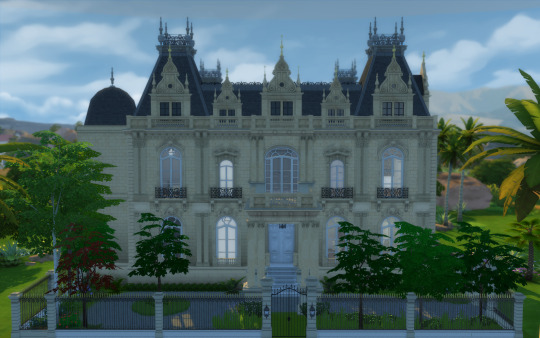
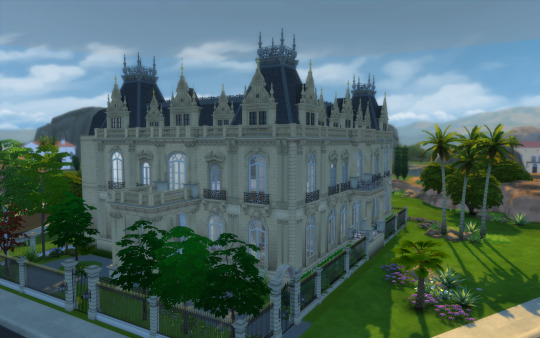




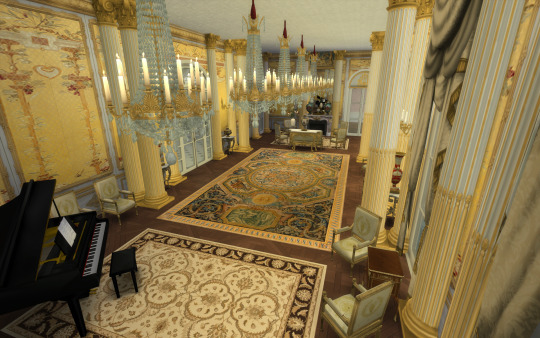


Ortiz Basualdo Anchorena Palace
Hi Guys! I leave this residence here. Could not find the floorplan, so I took some building liberties.
As always, you will need lots of CC for it to work properly, mostly from Felixandre, TheJim, SYB, Aggresivve Kitty, among others.
Thanks to my patreons for all the support! I really appreciate your participation and gives me a boost of confidence!
Please let me know if you like it :)
Enjoy!
DOWNLOAD: https://www.patreon.com/posts/81865201
--------------------------------------------------------------------------------------
A little bit of context and history:
The disappeared Ortiz Basualdo Anchorena Palace (better known as the Ortiz Basualdo Palace) was a luxurious residence that existed facing the San Martin Plaza in the neighborhood of Retiro, Buenos Aires.
This grand mansion, which occupied half a block bounded by Basavilbaso, Maipú, and Arenales streets, was designed by Belgian architect Jules Dormal at the request of Mrs. Magdalena Dorrego de Ortiz Basualdo (1826-1905) for her eldest daughter, Inés Ortiz Basualdo (1853-1922), widow of Estanislao Peña y Lezica, and her youngest son, Carlos Ortiz Basualdo (1863-1910) married to Matilde de Anchorena Castellanos, all members of important aristocratic families of late 19th century Argentina.
The mansion was completed in 1904, and that year, the Municipality of Buenos Aires awarded it the First Prize for Best Façade in its annual competition. This palace should not be confused with the one built in 1912 for Daniel Ortiz Basualdo (1860-1935), the second son of Mrs. Dorrego de Ortiz Basualdo, married to Mercedes Zapiola, at the corner of Cerrito and Avenida Alvear, now the Embassy of France.
The Ortiz Basualdo Palace, which appeared as a single unit, actually contained two important adjacent but independent residences. One with an entrance at Arenales 733, with a grand porte cochère, was that of Inés Ortiz Basualdo de Peña, who, already a widow, moved into it with her daughter Elisa Peña de Uribelarrea (1878-1943), newly married to Manuel Adrián de Uribelarrea Anchorena, a marriage that had ten children. In 1943, Elisa Peña de Uribelarrea died, already a widow, and the executor of the estate entered into negotiations to sell her part of the palace to the Russian embassy, which finally bought the house of Celedonio Pereda on Rodriguez Peña street.
The other great residence with an entrance at Maipú 1210 was that of Carlos Ortiz Basualdo, married to Matilde de Anchorena Castellanos in 1896. Carlos Ortiz Basualdo died in 1910, after having five children, four boys and one girl. Matilde de Anchorena Castellanos married François Verstraeten Dunois in 1914, with whom she had a son and a daughter. Her son, Francisco Verstraeten de Anchorena, married Raquel Terán Etchecopar in 1942, and her daughter, Elena Verstraeten de Anchorena, married Enrique Ibarguren in 1941. The Verstraeten Anchorena family lived in the palace until their last days. After the death of Doña Matilde de Anchorena Castellanos de Verstraeten in 1969, the remaining part of the palace was auctioned and demolished.
The Ortiz Basualdo Palace was one of the most important examples of the palaces and mansions that emerged in the early 20th century in the neighborhoods of Retiro, Recoleta, and Palermo. These mansions were clustered around the San Martin Plaza, along Avenida Alvear and adjacent streets. Until the crisis of 1930, family successions and the emergence of rationalism in architecture definitively put an end to them, both in aesthetic exhaustion and economic reality.
Credit:
Argentina de Antaño
#sims 4 screenshots#sims 4 architecture#sims4palace#the sims cc#sims 4 build#sims4#sims4living#sims4play#sims4royalty#sims4frencharchitecture#sims 4 building#french architecture#argentina_lost_history#palaciossims4#sims4palacios#sims4mansions
24 notes
·
View notes
Text
OC Masterlist as of 10/8/2023
My OCs (main):
Julie Kristina Lawrence
Fandom: The Karate Kid/Cobra Kai
(Primary) Story: Is This Love?
FC: Alyssa Milano (mainly 80s and 90s era)
Julie is the younger sister of Johnny Lawrence, Cobra Kai's star student. She has been in love with his friend Jimmy since she was a kid. As her senior year of high school comes to an end, something changes between them.
Alyssa Riley Morgan-Parker

Fandom: The Karate Kid/Cobra Kai
(Primary) Story: Never Knew
FC: Molly Jackson
Alyssa is the teenage daughter that Jimmy didn't know that he had. She comes to live with him and his family after losing the only stable adult in her life. Alyssa learns how to be a part of a family and gets caught up in the Valley's karate dojo wars.
Molly Alexandra Yates

Fandom: Doctor Who/The Sarah Jane Adventures
FC: Madeleine McGraw
Story: currently working on this title-less WIP
Molly is the granddaughter of Mike Yates, companion of the Third Doctor and former member of UNIT. She was raised in San Francisco by a single father. When she was a few months shy of turning fourteen, her dad moved them to his homeland of England. Molly makes fast friends with the other new girl in their Ealing neighborhood, Maria Jackson, and finds a mentor and mother figure in her grandfather's old friend, Sarah Jane Smith. Molly investigates alien and strange occurrences in and around Ealing with the rest of the Bannerman Road gang, while trying to unravel her own, personal mystery.
My OCs (supporting):
Rebecca Nicole "Becca" Brown
FC: Staci Keanan
The younger sister of Bobby Brown. Best friend of Julie Lawrence. Becca is an outspoken girl who doesn't back down, whether challenging Dutch or defending Julie.
Jenny, Jordan, Josh, Jesse, and Jayden Parker

FC: Khrystyne Haje (Jenny), Jimmy Deschler (Jordan), Grayson Russell (Josh), Jack Gore (Jesse), and Iain Armitage (Jayden)
Jenny is Jimmy's wife in canon, yet has never been seen, only referred to onscreen in one episode. My Jenny is a calm, loving, and level-headed woman, partner, and mother.
Jordan and Josh are Jimmy and Jenny's eldest sons, fraternal twins. Jordan is the athlete and Josh is the sensitive musician. They are each other's best friends. Jesse is/was the troublesome middle child, always getting into mischief. Jayden is the innocent baby of the family, only eight years old. Jenny and Josh were the first ones to welcome Alyssa into their family.
David Alexander Franklin Yates

FC: Jamie Bamber
The son Mike Yates didn't know he had until David was an adult. David is an architect who spent years working abroad in the States. He does the best he can as a single father. David is unaware of his father's past work with UNIT or much of what his daughter gets into with Sarah Jane.
My AO3
My Pinterest
Tags to search under: julie lawrence, is this love, is this love?, jimmy karate kid, julie verse, jimmy fic, jimmy x julie, alyssa morgan, never knew, alyssa verse, jimmy x jenny, jimmy parker, jenny parker, jimmy's family, molly yates
Most of my fics are WIPs and I do have OCs, both main and supporting, that I don't have listed because they haven't appeared enough to warrant it or I haven't written them yet.
#my ocs#invisibleobserver13#julie lawrence#is this love#never knew#alyssa morgan#molly yates#whoniverse fic#original characters#a masterlist of sorts#any questions feel free to ask
17 notes
·
View notes
Text
Pedantic, chapter two - a Malevolent AU
Arthur Lester is the best IT architect in the world, and the reason Carcosa, Inc. has its fingers in every pie. Government, medical, everyone in the world uses its systems. Arthur is also going blind and nearly gives up… until a deeply annoying cybersecurity programmer prods him into trying something new.
Chapter Two: It’s too much trust with too little information.
AO3
----------
The alarm was bad, and he felt bad.
Good morning, Arthur, said Cassilda, responding to his consciousness.
Damnable consciousness. Nobody needed it. Arthur grunted.
Do you wish for coffee?
Coffee; his grandmother would have lost her mind to see Arthur drinking it now instead of tea, but years working in Italy and then in San Francisco had made him something of a coffee fanatic. “Yes.”
He lay still while the smell filled his massive penthouse. Open concept taken to extremes, this place was one enormous square with specially coated glass floor to ceiling on all sides, so he could see everything and not be seen. The only actual opacity was around the bathroom, and while Arthur had still been able to see, that column of darkness in the middle of his precious, fading view was an affront.
He’d needed to see as much as he could, everything, everywhere, all the time.
It was pointless now, though. At night, he could no longer see, not even the nearest city lights. It was darkness. In day, it was blurr.
This disease wasn’t fully understood. It was genetic. Arthur’s family had handed it to succeeding generations like a toxic heirloom for hundreds of years. The doctors (Hastur ensured he had the best, no matter what country of origin) told him he was one of twelve known cases in the world.
The upshot of which meant that going blind happened to many people, but doing it like this had no cure.
Optical implants did not help; something was interfering with the actual signals in his brain. A full eye transplant did not help; poor Zhao had gone through that in Taiwan, but because the cause was somewhere else in the body, her new eyes still went dark.
Arthur knew he didn’t have much time left being able to do this all on his own. He’d been fighting since he was seventeen, doing everything he could to maintain his ability to see. The focus paid off, and the drive. He was fine, financially. He could retire right now, if he wanted to—as one of the best systems architects in the entire world, the jewel of Carcosa, Inc., he’d been paid very well.
But Arthur didn’t want to retire.
He would be making these systems even if he hadn’t been paid. He had to; he was driven, focused. Obsessed. He needed to keep working, creating, crafting better and better ways to handle the massive amount of data passing through Carcosa’s servers.
Damn near every country that could afford it used Play (a silly OS name, but Arthur liked it because it implied things like a closed structure, heavy editing, and trustworthy intention from beginning to end). It was flexible enough and secure enough for both military and political needs. Excellent for education and medical systems both. A person’s entire life was safe within Play.
(And he had said absolutely no to any lesser version of it being available for “just folks.” It was the full version or nothing. There would be no bastardized, trimmed down, pitifully gutted version of his masterpiece, thank you very much.)
He loved making things that just worked. Interfaces that were never confusing. He loved restraining and properly utilizing AI, loved tweaking those tiny, barely noticeable details that kept his GUI beautiful and sleek and made everyone who used it feel safe and well-regarded.
Arthur always made sure it met every damned security protocol. It wasn’t like he didn’t care about security. He just lacked Doe’s crystal ball or captured pixies or whatever the hell he used to predict whatever was coming down the pike.
Doe. John. He still didn’t know what to do about this bet. He rolled over and hid his face in the pillow.
Coffee’s ready, Arthur.
She made it sound divine.
He checked his feed as he staggered into the kitchen area (an island with a tiny stovetop and two refrigerated drawers—someone with the money for a penthouse like this was expected to eat out more than in) and listened to notifications and messages as he indulged.
Praise, mostly, of course. The new system had slid into place perfectly without disrupting anyone’s work-flow (which was his design ), and security was already reporting a significant decline of bad actors. Two countries had already needed Lullaby to save themselves from being digitally invaded.
Arthur checked. Yep, they’d invaded each other with malicious code. Unreal.
The last email was from Hastur. All it said was, Well done. Let’s talk about your next project.
There wouldn’t be one, no matter what John Doe said.
Arthur was young. He knew this. Thirty-four was hardly retirement age, especially when he didn’t want to, but… it wasn’t really an option, was it?
He’d been trying to work with Cassilda to code without being able to see, and… he couldn’t. He just couldn’t. It was trying to make music while deaf. It was trying to paint a portrait while colorblind. He could see what he wanted in his head, understand how to achieve it, but on the bad days…
On the bad days, he squinted an inch away from the screen, unable to make anything out at all.
Arthur switched off his feed and pulled up some old classic panel shows instead. A little David Mitchell ranting—beloved but long since deceased—could always get him in a good mood.
#
The commute was dull. His car drove itself. Arthur refused to engage with Doe.
Boring.
More congratulations as he got into the office, which was to be expected. He smiled, shook hands, took it as best he could, and finally retreated to his personal office space.
Glass, all around. Of course. And he could see… colors. Some shapes. The world made Impressionist, but he would not give up this hard-won office any more than he would his penthouse. Damn it. He’d cling to it as long as he could.
Hastur was calling.
Arthur sighed. “Pull up the video.” Because Hastur… Hastur really liked to see him, whether or not Arthur could see him back.
The three-dimensional image appeared over Arthur’s desk, full-size, beaming down from on high, and Arthur gave it his best smile. “Good to see you, sir.”
Even with fading vision, he could tell Hastur was having a great time. Blue sky rose behind him, and he was framed by figures in slinky gold. Faint music wafted through—strings, some instrumental version of classical music, Arthur thought by the Beastie Boys. And Hastur himself…
The old man was always a vision. Handsome, preened in that particular way only the very rich could be, he claimed to understand Arthur because of his own special needs: Hastur had lost his arms and legs as a soldier fighting in the war for Ythill. His disabilities, however, could be fixed with technology, and Hastur had gone hard.
Very few humans had the required intelligence and coordination to manage more than four limbs. Hastur managed ten: eight bionic tentacles below the waist, and a mere humble two above. He’d struck Arthur like some kind of wild, ancient god from the moment Hastur had recruited him; something out of myths and legends, who’d built an incredible company fulfilling incredible needs like a deity’s blessing.
Right now, Arthur could see several of the bionic limbs moving, doing who knew what off screen; Hastur was always multitasking. “Arthur. Brilliant. I have been instructed to give you presidential thanks.”
“Presidential? Which?”
Hastur smiled. “Several. It seems you’ve already stopped multiple ransomware attempts. You’ve done it again. You’re a boon to this company, Arthur.”
Relief. He would go out on a high note. “Thank you. Thank you, sir.” Arthur had not admitted he was going to quit after this. He had phrased it as taking vacation time.
Hastur knew, though. “Your next project.”
“Hastur, we… I told you I need a break.”
Hastur knew. “I know. You deserve vacation, and the rolled over days give you a while. But I want to know your next plan. Where can Carcosa be improved?”
And Arthur knew what he was doing. Trying to get him hooked on an idea, a project, a challenge—knowing all too well that the moment Arthur got truly invested, he could lose months in the planning and programming and execution. It was like blinders. It was like being driven by a vengeful muse.
And Arthur knew he couldn’t pull it off. There would be more errors, possibly dangerous ones like today. He couldn’t. “Hastur, we…”
Even from here, the old man’s face was hopeful, warm. Even if his eyes were like knives.
Arthur hated to disappoint him. He swallowed. “I’ll have an answer when I get back from vacation. As we discussed.”
“Yes, of course,” said Hastur, who clearly did not want to wait at all. “In the meantime, think of whatever you need for your new project, and I can supply it.”
The pressure was heavy. He owed Hastur everything. They both knew it. Arthur squirmed. “I haven’t taken a vacation in four years, sir.” Since his eyes began to really degenerate, and Zhao’s transplant had failed. Time off felt dangerously wasteful.
Hastur sighed. “Of course, Arthur. Whatever you need.”
“Thank you, sir.”
And then Arthur had to smile and nod through twenty-five minutes of business gossip and stocks and purchasing opportunities and business rivals.
It was fine. He didn’t have to respond—just listen.
All the while, Hastur’s limbs worked, mixing drinks for his guests, doing who knew what with his contracts and his followers. The man never did just one thing at a time.
Arthur’s phone buzzed. Cassilda read it off: Gonna answer me, coward?
That asshole Doe! Why did he always have to be so damned aggressive?
But was he?
Was it… humor, again? Abrasive, like a dog that always bites when playing, but… “Never a day in my life,” Arthur answered, murmuring.
“I knew you’d agree,” said Hastur, who was talking about short selling.
Then take the bet. Coward.
Arthur considered.
“This will allow us to expand,” said Hastur. “The Mnomquah moon base first, obviously. But if we can get Play to work for the Martian colony…”
An enormous challenge. So far, it had been impossible to achieve fast, secure connectivity between Mars and Earth because, you know, space. “It seems risky,” said Arthur to John.
“But a risk worth the reward,” said Hastur.
Don’t take it and you lose a chance at continuing the thing that gives you joy, said the voice in his head. Take it, and you risk nothing.
“I risk failing. That’s loss of hope,” said Arthur.
“Oh, son, not at all,” said Hastur lightly. “If it fails, you will try again.”
So then you only lose the thing you already fucking threw away, said John Doe with the gentle delivery of a linebacker. But at least you tried.
Arthur wanted to argue with them both, but one of them was actually right. He was giving up. Throwing hope away. “I guess it comes down to choosing to have more hope, then?”
Now you’re getting it.
“Now, you’re getting it,” said Hastur in eerie approximation of that digitized voice. He leaned in, and Arthur had the impression he was being studied. “I hope this isn’t a repeat of that moment of weakness two years ago.”
Two years ago, Arthur had considered quitting. Considered leaving and enjoying the world while he could still see it. Maybe going nuts and taking one of the ridiculously expensive civilian trips to the Martian Aihai base, or something.
Hastur had convinced him not to do it. To spend what time he had left creating instead, building his legacy—and Arthur didn’t mind that. This was what he loved, and he suspected he’d only have lasted a week without architecting something, anyway. (He’d had the thought of completely redesigning the entire Aihai base just out of twitchy need, and it made him laugh.)
Still. Hastur would push him to do something he didn’t want to do if he admitted how he felt right now, and Arthur did not like to be pushed. “No, sir,” he lied, knowing Cassilda would understand sir meant absolutely not John Doe.
Fuck!!!
Arthur jumped. The reader had been interpreted that as a yell.
Exclamation point, exclamation point, exclamation point, Cassilda helpfully read off.
Hastur seemed to be studying him again. Maybe his lie hadn’t been good enough.
Sorry. Spilled coffee approximately the temperature of the fucking sun all over hell.
Arthur’s lips twitched. “Are you all right?”
“Only if you are. You’re the soul of this company, Arthur,” said Hastur.
“What, not the heart, too?” Arthur teased.
“A heart without a soul is dead and unbeating. I need you, Arthur. Your innovation.”
It’s on my lap, not my chest. Weirdo.
How could this completely busted three-way conversation make him want to laugh when he really wanted to cry. “Sir, I…”
“You’re worrying me a little. In the wake of such a success you should be happier.”
Arthur sighed. “I just don’t know if I can do this.”
Both the other two were briefly silent.
“You will,” said Hastur, and it sounded almost like a threat.
You know what? Maybe not. But maybe you can. And I wanna be there either way.
“Why?” said Arthur.
“I believe I’ve already answered that,” said Hastur, low.
Maybe I don’t want to see the most brilliant man I’ve ever tangled with give up without a fight.
“I…” whispered Arthur, unsure whom he was responding to.
“You know what? You’re right, Arthur,” said Hastur. “You need a break. You’re burned out. I’ll have Kayne set up a vacation for you.”
Oh, he did not want that. “Sir, with all due respect, I can do it myself.”
“Nonsense. And put more on your clearly overburdened plate? You’re a tender soul, Arthur. I will see you taken care of.”
Arthur sighed. It wasn’t as if he had to do whatever bonzo-loco coo-coo-manic thing Kayne suggested. The man was just so fucking hard to say no to. “Sir…”
“No, no, I’ve taken enough of your time. Go take your break. I look forward to seeing you revived and ready to innovate.” Hastur toasted him with a weirdly shimmering gold drink.
“Thank you, sir. Have a good day.” He made the hand gesture to shut the call off.
Arthur slumped in his seat with a moan. This was going to be so hard. How the hell could he get Hastur to understand? Hastur had plucked him from obscurity when he was fifteen, based entirely on a project Arthur built for a contest to redesign the local waste facility’s system. He’d believed in Arthur. Always supported him. How could—
Still haven’t answered me. Coward.
“Still thinking. Prick.”
I await your graciousness’s response with eagerness, said the reader with none of the sarcasm that Doe surely intended.
Arthur snorted. “You’re serious about this?”
Completely.
Was there really anything to lose?
More pain to gain, maybe. A second loss of hope.
But… he would have tried. Surely that mattered. To be able to enter full darkness with no regrets…
Arthur took a deep breath. “All right, Doe. You’re on.”
John. And fuck yeah.
“John.”
Took you long enough, Just Arthur.
John Doe may be a bitey dog, but he wasn’t, maybe, a mean one. “I’ll let you know what the project will be. Do we need a contract, or something?”
If you want. I don’t feel like I need to be protected against you. You’ve got a good rep.
John didn’t have enough of a rep for Arthur to make that guess regarding him. “I’ll let you know.”
I’ll be waiting.
It was time to make a call.
#
It hadn’t been a bad breakup. It really hadn’t. Parker had never been pushy, even when Arthur was at his worst. They just… hadn’t worked as lovers.
They were better friends. And Arthur didn’t have a lot of those.
He usually didn’t call for business, though. “Hey.”
“Hey.” Parker sounded surprised. It was only about five in the afternoon in San Fran, and he was probably still at work. “Everything okay?”
“That obvious I need something, huh?”
Parker’s chair creaked as he leaned back. Arthur could imagine it all too well—his office, papered in clues and letters and reports and photos, analog to the core because he believed seeing it all jogged the human brain in a way digital renditions didn’t. “You’re not in the middle of a project, which is when you usually call to bitch. Congrats, by the way.”
“Thanks,” Arthur said, smiling a little.
“It’s not the weekend, which is also when you usually call after you’ve had a bunch to drink alone,” said Parker.
“Hey, I’m not always alone,” Arthur protested.
Parker ignored that lie. “So what’s up?”
“Can you look into someone for me?”
Another creak as Parker leaned forward. “Professionally or personally?”
“Parker, what the hell does that mean?”
“I mean do you want to date the guy, or is this a business venture?”
“What the hell difference does it make?”
“One means I tell you anything I can find about the guy. The other means I elaborate on his resume.”
This was about trust. It had to be personal. “I’m not dating anybody, but I want the former. I’m giving this guy access to my code as I write it, Parker.”
Parker understood that. “Shit. You sure you’re not dating him?”
“I’ve never even met him. He lives in New York City.”
Another creak. “Okay. I’ll do it. Name?”
“John Doe. Head of cybersecurity for Carcosa.”
Parker paused. “You realize I won’t be able to learn a lot about a guy who’s that into security.”
“Just everything you can. He came out of nowhere a year ago. That’s not good enough.”
“All right. Yeah, I can do this. When do you need it?”
“ASAP. I’m paying your expedited rate.”
“Arthur, you don’t gotta pay me nothing.”
“Double negative. So we agree.”
“Arthur.”
“I’m paying you. Shut up.”
“Fine.” Parker’s voice betrayed his smile. “ASAP.”
“Thanks.”
“Sure.”
They said their goodbyes and Arthur got to work, answering questions from the press, turning down interviews (he always did), choosing charities to put money into, choosing schools to fund for their IT programs.
His legacy. He knew it mattered. One such program had given him everything he now had.
The time passed slowly; it always did, after a project launched, and no matter how tired he was, he hated the sluggishness of downtime. He handled office requests, signed off on a few smaller projects still under his mantle, and by the time he was done with all of that, he knew what his next project would be.
A new idea always felt so damn good. Now he had to wait for Parker to do his own magic.
------
CHAPTER THREE
#john x arthur#arthur x john#malevolent#malevolent podcast#malevolent fic#malevolent fanfic#john doe malevolent#arthur lester#kayne malevolent#malevolent au#pedantic fic
3 notes
·
View notes
Text



Nonfiction Thursday: National Parks
The Power of Scenery by Dennis Drabelle
Wallace Stegner called national parks “the best idea we ever had.” As Americans celebrate the 150th anniversary of Yellowstone, the world’s first national park, a question naturally where did the idea for a national park originate? The answer starts with a look at pre-Yellowstone America. With nothing to put up against Europe’s cultural pearls—its cathedrals, castles, and museums—Americans came to realize that their plentitude of natural wonders might compensate for the dearth of manmade attractions. That insight guided the great landscape architect Frederick Law Olmsted as he organized his thoughts on how to manage the wilderness park centered on Yosemite Valley, a state-owned predecessor to the national park model of Yellowstone. Haunting those thoughts were the cluttered and carnival-like banks of Niagara Falls, which served as an oft-cited example of what should not happen to a spectacular natural phenomenon.
Olmsted saw city parks as vital to the pursuit of happiness and wanted them to be established for all to enjoy. When he wrote down his philosophy for managing Yosemite, a new and different kind of park, one that preserves a great natural site in the wilds, he had no idea that he was creating a visionary blueprint for national parks to come. Dennis Drabelle provides a history of the national park concept, adding to our understanding of American environmental thought and linking Olmsted with three of the country’s national treasures. Published in time to celebrate the 150th anniversary of Yellowstone National Park on March 1, 2022, and the 200th birthday of Frederick Law Olmsted on April 26, 2022, The Power of Scenery tells the fascinating story of how the national park movement arose, evolved, and has spread around the world.
Leave Only Footprints by Conor Knighton
When Conor Knighton decided to spend a year wandering through "America's Best Idea," he was worried the whole thing might end up being his worst idea. But, after a broken engagement and a broken heart, he desperately needed a change of scenery. The ambitious plan he cooked up went a bit overboard in that department; Knighton set out to visit every single one of America's National Parks, from Acadia to Zion.
Leave Only Footprints is the memoir of his year spent traveling across the United States, a journey that yielded his "On the Trail" series, which quickly became one of CBS Sunday Morning's most beloved segments. In this smart, informative, and often hilarious book, he'll share how his journey through these natural wonders, unchanged by man, ended up changing his worldview on everything from God to politics to love and technology. Whether it's waking up early for a naked scrub in an Arkansas bathhouse or staying up late to stargaze along our loneliest highway, Knighton goes behind the scenery to provide an unfiltered look at America. In the tradition of books like A Walk in the Woods or Turn Right at Machu Picchu, this is an irresistible mix of personal narrative and travelogue-some well-placed pop culture references, too-and a must-read for any of the 331 million yearly National Parks visitors.
Guardians of the Valley by Dean King
In June of 1889 in San Francisco, John Muir—iconic environmentalist, writer, and philosopher—meets face-to-face for the first time with his longtime editor Robert Underwood Johnson, an elegant and influential figure at The Century magazine. Before long, the pair, opposites in many ways, decide to venture to Yosemite Valley, the magnificent site where twenty years earlier, Muir experienced a personal and spiritual awakening that would set the course of the rest of his life.
Upon their arrival the men are confronted with a shocking vision, as predatory mining, tourism, and logging industries have plundered and defaced “the grandest of all the special temples of Nature.” While Muir is devastated, Johnson, an arbiter of the era’s pressing issues in the pages of the nation’s most prestigious magazine, decides that he and Muir must fight back. The pact they form marks a watershed moment, leading to the creation of Yosemite National Park, and launching an environmental battle that captivates the nation and ushers in the beginning of the American environmental movement.
Walks of a Lifetime in America's National Parks by Robert & Martha Manning
Walk the national parks and find out for yourself why they’re “America’s best idea” and why walking is the richest way to experience and appreciate these iconic places. There can be no better guides than Bob and Martha Manning, longtime Hiking Ambassadors for the American Hiking Society and life-long stalwarts of the National Park System. In this book, the Mannings introduce and describe all the national parks and offer first-hand descriptions of the very best trails that lead walkers to quintessential scenic vistas, celebrated rivers and lakes, majestic waterfalls, outstanding wildlife viewing areas, significant historic and prehistoric sites, and much more. These walks range from short nature trails to half and full-day hikes to backpacking trips. The book is richly illustrated with hundreds of color photographs, and concludes with a wealth of practical advice on how to best visit and hike the national parks.
#travel#nature#library books#reading recommendations#reading recs#book recommendations#book recs#tbr#tbrpile#to read#book tumblr#booklr#book blog#library blog
4 notes
·
View notes
Text
Druid Heights: Northern California Legacy

Go north of San Francisco, through the woods of Marin, up the southern side of Mount Tam, and you may find what remains of Druid Heights. This is the name of the bohemian community that settled there in 1954, led by poet Elsa Gidlow. Gidlow was best known for On a Grey Thread, thought to be the first book of openly lesbian love poetry published in North America. Initially envisioned as a secluded retreat, Druid Heights quickly attracted other trailblazers: Beats like Allen Ginsburg, queer radicals, women's liberation activists who came to socialize or get away from socializing. For many, it was a place to party and listen to music: The Rolling Stones, Neil Young, and the Eagles all played there. A few made it their home, like philosopher Alan Watts who moved there in 1971, had a library built, and died soon after. The countercultural figures who visited this fabled five acres remain in popular memory. The buildings they stayed in have had a more precarious history.
These were designed by Roger Somers, a carpenter-turned-architect who with his white beard and maharishi clothing looked somewhat like a druid himself. A Somers house is wooden and seemingly inspired by Indonesian batak houses, Japanese stone gardens, Frank Lloyd Wright's Usonian fancies, and The Hobbit. They made perfect sense, but probably only if you were on any number of drugs at any number of parties that made the retreat infamous.
The party lasted long after Druid Heights' heyday—lasted probably until 2001, when Somers died in his hot tub on site. It was definitely over by 2006 after the National Parks Service, which had used eminent domain to seize the land in 1977, evicted all residents who did not have permanent leases. Since then, the forest has slowly reclaimed its territory, and only the occupied buildings are in sound condition.
The Parks Service has shown little interest in maintaining what is left. In 2017, a campaign was launched to save the Heights, to little effect; and the few remaining residents are in their 80s. Is this a fitting end? Watts once wrote: "What makes this world a beautiful experience is the impermanence and mutability of all things." Druid Heights was based on spontaneity, anarchism, improvisation—a preservation society is the opposite of this. In a culture of constant growth and productivity, one in which we expect all things to remain available at all times, to let the Heights decay into the past is perhaps the most countercultural action to take. But the Heights also represents an authenticity rare in a radically changed Bay Area that has allowed its cultural heritage to vanish or corporatize; perhaps then the most subversive act is to save it, and to save it for the same reasons we want to save the redwoods that surround it: because it is unique, because it is there, because places like it can't grow just anywhere and might never come again.
Elsa Gidlow in her shoji room.






Gidlow and Watts in the gardens of Druid Heights.


Gidlow in her bedroom surrounded by her books.

8 notes
·
View notes
Text
The Looff Hippodrome
Looff Hippodrome is a landmark of Santa Monica, California. It is a beautiful and historical structure that has been cherished by the community for decades, and it remains one of the most gorgeous backdrops for movies and television shows.
The Looff Hippodrome is a unique building that was built in 1916 by Charles I. D. Looff, who was a world-renowned carousel crafter and amusement park developer. He and his son Arthur worked primarily on the West Coast, designing and building carousels, roller coasters, Ferris wheels and full-scale amusement parks.
Although Looff designed many of his own rides and structures, he was also responsible for the carousel at Coney Island in Brooklyn. He and his family were German immigrants who came to the United States in the late 1800s and made a name for themselves as amusement park empresarios.
Their company built amusement parks, roller coasters and carousels across the country, including those in California, and even at the 1915 Panama Pacific International Exposition in San Francisco. They were well-known for their whimsical style and the fanciful designs of their carousels, which were hand-carved from wood.
Architects of this time sought to make their buildings as visually appealing as possible, and they incorporated elements from many different architectural traditions into their design. This was especially true of carousel buildings, which typically sported octagonal towers at three corners and a cupola that was inspired by a Russian onion dome.
Today, the Looff Hippodrome is a National Historic Landmark, and it has been carefully restored over the years. It is a wonderful example of the kind of whimsical architecture that made this period so popular.
It is also a testament to the dedication and devotion of people in the community who have tried their best to preserve the historic integrity of this landmark. For instance, when the city proposed a plan to tear down the pier and Hippodrome in order to build a bridge to a man-made resort island, a group of activists formed the Save Santa Monica Bay organization to fight the plans.
They successfully lobbied the city council to keep the pier and Hippodrome intact. It was a long and difficult battle, but their persistence paid off in the end.
The Hippodrome itself is a beautiful and charming building, and it was a great addition to the Santa Monica Pier. It still features a beautiful hand-carved merry-go-round, a Philadelphia Toboggan Company Carousel #62, which was originally built for Venice Pier in 1922.
Visitors today enjoy riding on this beautiful merry-go-round. Its fanciful painted upper rim and 1,100 electric lights add to its historic charm.
For those who want a real taste of this magical building, there are plenty of tours available. These tours can be booked online, and they are a great way to see the Hippodrome from inside.
The merry-go-round itself is a beautiful, hand-carved, wooden ride that is in excellent condition. It is also one of the few remaining original merry-go-rounds in the country, which makes it very rare and special.
3 notes
·
View notes
Text
10 Most Overlooked Women in Architecture: Norma Merrick Sklarek
Editor's Note: To celebrate Women's History Month, we're reposting a one of the articles in our series from 2015: "10 Most Overlooked Women in Architecture."
In 2013 ArchDaily ran a post on the 10 Most Overlooked Women in Architecture History. This post is the ninth in a series of mini-tributes to each of these architects. Read the previous post on Anne Tyng.
"Architecture should be working on improving the environment of people in their homes, in their places of work, and their places of recreation. It should be functional and pleasant, not just in the image of the ego of the architect." --Norma Sklarek
Norma Merrick Sklarek was born in 1928 in Harlem, New York City to West Indian immigrants. Norma's father was a doctor.1 She studied at Barnard College and "Columbia University's School of Architecture, an accomplishment all on its own considering that Columbia only accepted a handful of women each year"(1) during that time.
In 1950, after graduation, Sklarek could not find employment in an architecture firm and worked for the City of New York. She was not satisfied with her civil servant job, as she wanted to find work as an architect. She was eventually hired in 1955 by Skidmore, Owens and Merrill (SOM). (2) She worked for SOM for four years, then headed west to join Gruen Associates in Los Angeles, California.1
Her accomplishments in the field of architecture are so impressive it may be best to list them all:
First African-American woman to be licensed as an architect in New York (1954) and in California (1962) (2)2
First African-American woman director of architecture at Gruen Associates in Los Angeles1
In 1959, the first African-American woman to become a member of the American Institute of Architects (AIA) (2)
In 1980, the first woman to be elected a Fellow of the AIA (2)
In 1985, the first African-American woman architect to form her own architectural firm: Siegel, Sklarek, Diamond (1)
In 2008 Sklarek was honored with the Whitney Young Jr. Award at the AIA National Convention in Boston (2)
Ms. Sklarek's best known works include:"City Hall in San Bernardino, California, the Fox Plaza in San Francisco, Terminal One at the Los Angeles International Airport and the U.S. Embassy in Tokyo."3 She also taught graduate architecture courses at"UCLA, Columbia and Arizona State University"(1).
At the time of Sklarek's death in 2012, 10,000 of the 250,000 professional architects in the United States are African-American. (1 )Through her actions and her work, Sklarek was a role model and mentor to aspiring African-American and women architects alike.

Norma Merrick Sklarek, U.S. Embassy Office Building (1976),Tokyo, Japan. Image source.
References
Biography.com, (2015). Norma Sklarek. The Biography.com website. http://www.biography.com/people/norma-sklarek-7326.
Craven, J., (2012). Norma Merrick Sklarek, Breaking Barriers for Black American Women. The about.com website http://architecture.about.com/od/architectsaz/p/sklarek.htm
African American Registry (n.d.), Norma Sklarek Pioneered Black Women Architects. Online African American Registry http://www.aaregistry.org/historic_events/view/norma-sklarek-pioneered-black-women-architects
2 notes
·
View notes
Text
Electrical and Roofing Contractor Data Scraping
If you’re looking for an electrical and roofing contractor online, it’s about to be much simpler. That’s because many of these contractors usually have information on their websites about the services they provide. It’s important to find a Contractor Data Scraping Service or software that can help you get everything you’re looking for in one place.
Electrical and Roofing Contractor Data Scraping Services
This offer is perfect for any contractors looking to collect data from local businesses. We will provide you with the most up-to-date information about your industry and save you time in the process. Updates come out weekly, and we make it easy to order custom reports. Moreover, this offer provides an automated system that scrapes data from Home Advisor's directory, so it's easier than ever to get accurate information.

Contractor Data Scraping
The DataScrapingServices team employs a variety of techniques in data scraping, including web scraping, third-party services, and APIs. Our top priority is customer success, and with this in mind, you’ll find affordable rates for every budget. You can also rely on us for support when it comes to gathering key contact information about those in your network or for individual use. We know that accuracy is important when recording key contacts, so we utilize our data-scraping expertise to collect this information quickly.
List of Data Fields
DataScrapingServices is an expert in scraping data from various websites using contractor data scraping services.
Contractor Name
Contact Name
Street Address
City
State
Zip
Phone
Fax
Email
Website
Business Category
Review
Business Ratings
Popular Contractor Directories List
We extract contractor data from the following list of directories:
Angi.com
Buildzoom.com
Contractorleadshq.com
Everycontractor.com
Easyleadz.com
Fountain.com
Homeadvisor.com
Homestars.com
Houzz.com
Manta.com
Merchantcircle.com
Superpages.com
Thumbtack.com
Yelp.com
Popular Contractor Service Category
Architect
Contractors
Dentists
Doctors
Electricians
General Contractors
Home Builder
HVAC Repair
Physicians
Plumbers
Real Estate Agent
Repair Solar Panels
Roof Cleaning
Roofing Contractors
Wedding Vendors
Why choose us?
With our Contractor Data Scraping Services, you’ll be able to obtain the latest Contractor data from any website or directory, regardless of whether it’s on a mobile or desktop device.
Using our Contractor data scraping services, you can collect information on potential contractors.
With our Contractor data scraping services, you can collect home contractor, local contractor, and roofing contractor data for your real estate market conditions.
Best Contractor Data Scraping Services in USA: New York, Los Angeles, California, Chicago, Illinois, Houston, Texas, Phoenix, Arizona, Philadelphia, Pennsylvania, San Diego, Dallas, San Jose, Austin, Jacksonville, Ohio, Indianapolis, Indiana, Charlotte, North Carolina, San Francisco, Seattle, Washington, Denver, Colorado, DC, Oklahoma, El Paso, Boston, Massachusetts, Detroit, Michigan, Memphis, Louisville-Jefferson County, Kentucky, Baltimore, Maryland, Milwaukee, Wisconsin, Albuquerque, Tucson, Fresno, Sacramento, Kansas City, Missouri, Mesa, Atlanta, Georgia, Omaha, Nebraska, Colorado Springs, Colored, Raleigh, Long Beach, Virginia Beach, Miami, Oakland, Minneapolis, Tulsa, Bakersfield, Wichita, Arlington, Texas, Nashville-Davidson, Tennessee, Oklahoma City, Fort Worth, Columbus, Portland, Oregon, Las Vegas, Nevada.
If you are looking for Contractor Data Scraping Services and Electrical and Roofing Contractor Data Scraping then email us at [email protected].
Website: datascrapingservices.com.
Skype: nprojectshub
1 note
·
View note
Photo

Deer Park Residence in #SanRafael, California (USA) by DNM Architecture @dnmarchitecture. Photography: Jamie Leasure This project in Marin County, CA, north of San Francisco, is built on a lot that was vacant when purchased by the client. The V-shaped site has a natural drainage swale through its center, effectively dividing the land in half. The site’s natural topography simultaneously presents a challenge and an incredible opportunity for a unique build with and amazing view of Mt. Tamalpais and nearby hillsides… #usa #california #архитектура www.amazingarchitecture.com ✔ A collection of the best contemporary architecture to inspire you. #design #architecture #amazingarchitecture #architect #arquitectura #luxury #realestate #life #cute #architettura #interiordesign #photooftheday #love #travel #construction #furniture #instagood #fashion #beautiful #archilovers #home #house #amazing #picoftheday #architecturephotography #معماری (at San Rafael, California) https://www.instagram.com/p/CoFyeUuuvsx/?igshid=NGJjMDIxMWI=
#sanrafael#usa#california#архитектура#design#architecture#amazingarchitecture#architect#arquitectura#luxury#realestate#life#cute#architettura#interiordesign#photooftheday#love#travel#construction#furniture#instagood#fashion#beautiful#archilovers#home#house#amazing#picoftheday#architecturephotography#معماری
25 notes
·
View notes